Showing 1–24 of 282 results

Who is this book for?
Business and Money Matters in English is a reading and writing course for students of Business Studies and Economics at Tertiary Education who have acquired considerable competence in General English and have a working knowledge in their field of study. The material of this course book is of an upper-intermediate level of English responding to the students’ need to increase their effectiveness in reading and interpreting texts in their subject area, and to develop their writing skills in English as part of their studies or work.
Organization of material
The material is organized into eighteen thematic units, which comprise the three parts of the book. Part I focuses on key economic concepts, Part II covers the most important areas of accounting and finance and Part III explores topics on management and marketing.
Each unit is theme-based and the related subjects are presented in the reading texts of the unit. The texts are followed by a variety of comprehension and vocabulary exercises on similar topics which aim to develop the students’ understanding of business and economic texts and encourage them to ponder over the subject.
In the Language Use passages, the cloze technique has been adopted to identify language problems of some difficulty and thus provide the input to the teaching of grammar.
The Skills You Need component, present in each unit, aims to develop students’ skills in writing on specific subject-matter, such as describing processes and graphics, writing abstracts, writing reports, and other practical tasks. To serve this purpose it provides examples of different types of texts to help students see the principles according to which they are organized.
The Language Reference Section provides insights into the process of writing and focuses on the language structures which are needed for all types of writing assignments; students can resort to it when performing such tasks throughout the course. Furthermore, additional key skills are pointed out, such as writing references, making oral presentations, dealing with numbers.
The book also includes a Glossary of Business and Economic Terms and their Greek equivalents, as well as a Key to selected exercises.
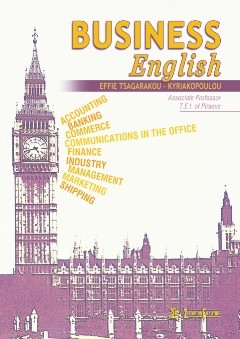
The book will assist readers to read, understand, speak and write in Business English, so as to communicate fluently and correctly with people in their professional environment. Also, it will enable them to use English bibliography, as well as, translate in their own language authentic Business English texts. The material of the book is presented in 20 units. Every unit has: a passage, a glossary on the passage, reading comprehension exercises, terminology practice-exercises, grammar review, action-exercises, writing-exercises. There are also authentic texts for translation and business correspondence. At the back, also, there is a glossary of special terms and an answer key.
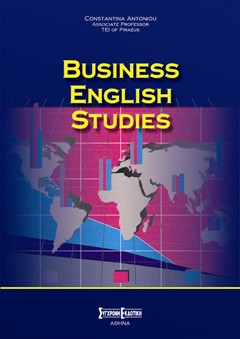
Business English Studies consists of two parts. Part I contains 23 units based on authentic texts and accompanied with a wide range of tasks and activities while Part II contains Business Letters referring to different situations, accompanied with a variety of tasks to develop reading skills and training in writing skills as well. This book will enable readers to learn up to date business terms, understand authentic texts, improve their communicative competence and write Business letters and reports.
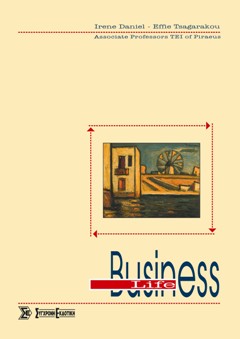
The book contains 17 chapters, 2 of which are assessment tests composed of several grammar revision items. The running order of a chapter is: a passage with glossary, reading comprehension-exercises helping to read, understand and enjoy the reading passage, vocabulary practice, structural practice, communication activity and puzzle-in an enjoyable way helping to practice the most complicated words and terms of the passage. After the last chapter there is a general glossary of all the words included in the book and there are appendices referring to the Irregular Verbs, the Sounds of English and the British Currency. At the end of the book there is an answer key to all shorts of exercises provided for self-correction.
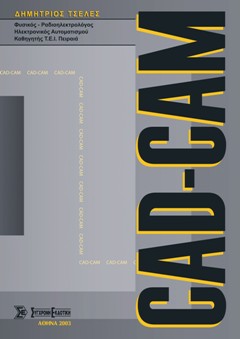
H αλματώδης ανάπτυξη της τεχνολογίας των υπολογιστικών συστημάτων, κατά τις τελευταίες δεκαετίες, είχε ως αποτέλεσμα την ανάπτυξη νέων μεθόδων παραγωγής, οι οποίες εξασφαλίζουν αύξηση στην παραγωγικότητα και βελτίωση στην ποιότητα των παραγομένων αγαθών. H χρήση των υπολογιστών, με ολοένα αυξανόμενο ρυθμό, συνέβαλε στο να υπερκερασθούν προβλήματα της συμβατικής τεχνολογίας και οριοθέτησε την εμφάνιση και ανάπτυξη νέων τεχνολογιών της παραγωγής. Oι τεχνολογίες αυτές εξελίσσονται ταχύτατα, δημιουργώντας ένα πλαίσιο υποδομών για την ολοκληρωμένη αυτοματοποίηση της παραγωγικής διαδικασίας.
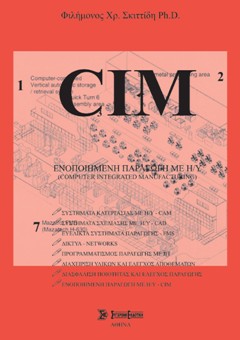
Το βιβλίο αυτό γράφτηκε με σκοπό να βοηθήσει τον αναγνώστη στην κατανόηση των εννοιών που εμπεριέχονται στην τεχνολογία της Ενοποιημένης Παραγωγής με Ηλεκτρονικό Υπολογιστή (Computer Integrated Manufacturing – CIM) και να βοηθήσει στην εφαρμογή αυτών των εννοιών σε πραγματικές συνθήκες παραγωγής στη βιομηχανία. Το βιβλίο “CIM – Ενοποιημένη Παραγωγή με Ηλεκτρονικό Υπολογιστή”, αποτελεί ένα πολύτιμο εργαλείο γνώσης για αυτούς που σκοπεύουν να υιοθετήσουν την τεχνολογία CIM.
Στα πρώτα 7 κεφάλαια του παρόντος βιβλίου γίνεται μία προσέγγιση των τεχνολογιών που απαιτούνται για την υλοποίηση του CIM σε κατασκευαστικό περιβάλλον.
Οι τεχνολογίες αυτές βασίζονται στην επιστήμη της πληροφορικής και αποτελούν τα βασικά μέρη του παζλ που λέγεται CIM. Οι τεχνολογίες είναι:
ΣΥΣΤΗΜΑΤΑ ΚΑΤΕΡΓΑΣΙΑΣ (Ή ΜΕΤΑΠΟΙΗΣΗΣ Ή ΠΑΡΑΓΩΓΗΣ) ΜΕ Η/Υ (COMPUTER AIDED MANUFACTURING SYSTEMS – CAM). ΣΥΣΤΗΜΑΤΑ ΣΧΕΔΙΑΣΗΣ ΜΕ ΤΗ ΒΟΗΘΕΙΑ ΗΛΕΚΤΡΟΝΙΚΟΥ ΥΠΟΛΟΓΙΣΤΗ (COMPUTER AIDED DESIGN – CAD). ΕΥΕΛΙΚΤΑ ΣΥΣΤΗΜΑΤΑ ΠΑΡΑΓΩΓΗΣ (FLEXIBLE MANUFACTURING SYSTEMS – FMS). ΒΑΣΙΚΕΣ ΑΡΧΕΣ ΤΟΠΙΚΩΝ ΔΙΚΤΥΩΝ ΥΠΟΛΟΓΙΣΤΩΝ . ΠΡΟΓΡΑΜΜΑΤΙΣΜΟΣ ΠΑΡΑΓΩΓΗΣ ΚΑΙ ΠΡΟΣΕΓΓΙΣΗ JUST-IN-TIME (JIT). ΔΙΑΧΕΙΡΙΣΗ ΥΛΙΚΩΝ ΚΑΙ ΕΛΕΓΧΟΣ ΑΠΟΘΕΜΑΤΩΝ. ΔΙΑΣΦΑΛΙΣΗ ΠΟΙΟΤΗΤΑΣ ΚΑΙ ΕΛΕΓΧΟΣ ΠΑΡΑΓΩΓΗΣ. ΕΝΟΠΟΙΗΜΕΝΗ ΠΑΡΑΓΩΓΗ ΜΕ Η/Υ
Θεωρήθηκε αναγκαίο να προηγηθεί στο βιβλίο η περιγραφή αυτών των τεχνολογιών επειδή ο αναγνώστης όταν φθάσει στο 8ο κεφάλαιο θα πρέπει να γνωρίζει τις τεχνολογίες που προσδοκούμε να ενοποιήσει η εφαρμογή του CIM.
Επιδιωκόμενοι στόχοι:
Η εισαγωγή του αναγνώστη στη φιλοσοφία της Ενοποιημένης Παραγωγής με Ηλεκτρονικό Υπολογιστή (CIM) και η επεξήγηση των διαφόρων εννοιών του CIM.
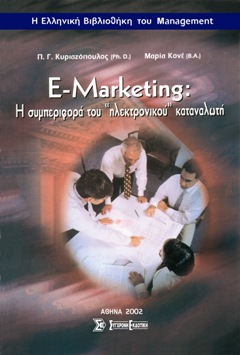
H παρούσα εργασία παρουσιάζει τους «νέους» καταναλωτές της οικονομίας του Διαδικτύου, τα νέα δεδομένα στο χώρο του εμπορίου και τα καινούργια ερωτήματα και προβλήματα που παρουσιάστηκαν στην αγορά. Eρωτήματα όπως: «Ποια είναι τα πραγματικά προβλήματα σχετικά με τη διατήρηση των προσωπικών δεδομένων των πελατών;».
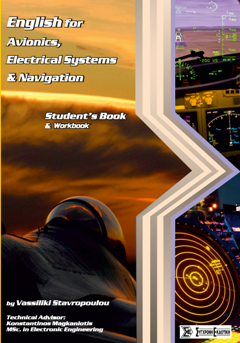
FROM PREFACE
English is the international language of aviation –and therefore the language most frequently used in technical and maintenance documents–, but it is often not the native language of the maintenance personnel who use technical manuals. As a result, complex technical instructions can be misunderstood by those without strong English language skills. A misunderstanding of instructions can lead to accidents. A study on language errors in aviation maintenance found that the most common errors occur in both written and spoken English. The study also revealed that maintenance personnel with better reading skills made fewer language errors. Consequently, improving the language skills of aviation professionals can have a significant impact on communication, which can lead to improved aviation safety.
English for Avionics, Electrical Systems and Navigation (Student’s Book, Volume 1) focuses on aviation English used for communication purposes by avionics and electrical engineers, as well as by pilots. It focuses on the learners’ reading, speaking, listening and writing skills and presents some of the most important lexical items and expressions that engineers, engineering technicians and pilots need in their work environment. Grammar practice is provided, and the target structures are contextualized in each unit.
English for Avionics, Electrical Systems and Navigation (Student’s Book, Volume 1) does not aim at teaching the subject-matter of aeronautical engineering. The purpose of the book is to show how language is used as a medium for communication in aviationrelated settings, and to give students a comprehensive grounding in communication skills in English.
This book consists of two volumes (the Student’s Book – Volume 1, and the Workbook – Volume 2). The Workbook (Volume 2) contains activities and exercises based on the skills and vocabulary covered in the Student’s Book. It is aimed at consolidating the material covered in each unit. It also contains a bilingual (English-Greek) glossary of vocabulary used in the Student’s Book.
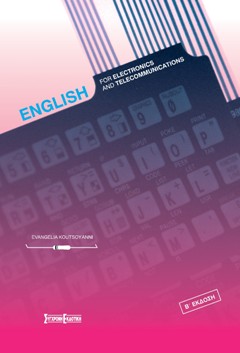
The material is organized into twelve thematic units, each one divided into two sections. The reading passages are authetic taken from a variety of sources and cover a wide range of topics, from simple components to communication systems.
In Section A, emphasis is put on vocabulary acquisition and interpretation of scientific texts. In Section B, the aim is to familiarize readers with a variety of texts and help them develop various reading strategies and improve their reading efficiency for using reference materials, manuals, product catalogues, etc.
This book does not include exercises for practising various grammatical phenomena but the Language Reference Section presents the language structures and functions commonly used in technical texts. A Glossary of Electronic Terms and their Greek equivalents as well as Key to selected exercises are included in the book.
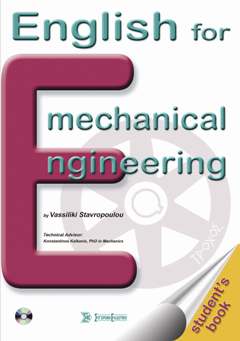
English for Mechanical Engineering is a course intended for upper-intermediate and advanced level learners of English (B2-C2) studying mechanical engineering, or for people already working in the field (i.e. the aircraft industry, the automotive industry, the marine industry). It is suitable for use in university and technical school settings, or in-company training programs. It can also be used for self-study.
English for Mechanical Engineering is content-based and covers a wide range of mechanical engineering topics, using adapted texts from various sources such as websites, magazines, dictionaries, encyclopedias. All four skills –listening, speaking, reading and writing– are developed through stimulating tasks which enable students to combine their knowledge of English with their technical knowledge. It can be used in combination with the Study Guide on Mechanical Engineering Terminology, as a complete course over a longer period, or independently. It contains twelve units. Each one is designed to provide approximately four to five hours’ work.
Key features of the Student’s book
. Twelve content-based units.
. Pre-text tasks to activate students’ background knowledge.
. Reading skills development.
. Vocabulary development.
. A variety of writing tasks.
. Frequent opportunities for discussion.
. Focus on using functional language.
. A useful notes section at the end of each unit which provides supplementary information and additional resources.
. Three revision tests.
. Full answer key and transcripts, so learners can check their own progress.
. Two concise glossaries of mechanical engineering.
Audio CD
It contains all the listening texts.
Course components
. Student’s book
. Study Guide
. Audio CD
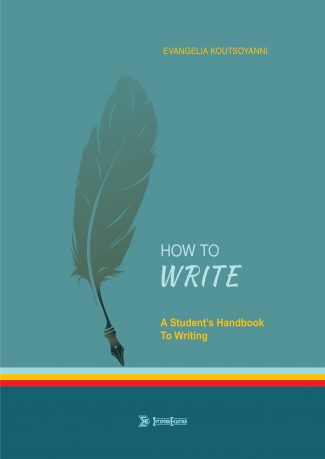
The How to Write handbook is designed for university students whose English as a foreign language is at post-intermediate level of proficiency and who need to develop their writing skills for academic purposes. The aim is twofold: (a) to enable non-native speakers of English who wish to attend a course of study in which English is the language of instruction to express themselves coherently in writing and (b) to increase students’ efficiency in writing a research report or other assignments across the curriculum. The handbook can also help students who prepare for an English language examination by expanding vocabulary areas and developing grammatical accuracy.
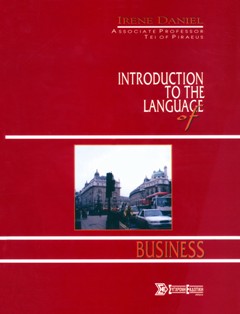
This book is a text book to improve the communicative skills in English of those who have a special interest in the world of business. The entry level is intermediate to upper-intermediate. It is based on a variety of authentic articles from prominent business magazines, books and reports. At the end of the book is a grammar section, a list of irregular verbs, a glossary and answer key.
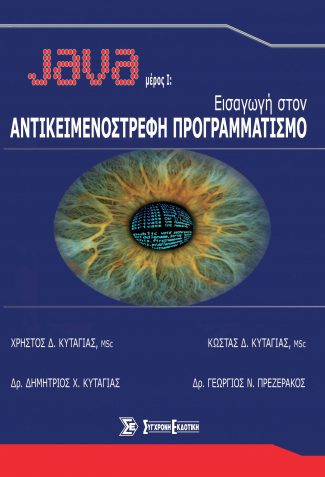
Στόχος του παρόντος βιβλίου είναι να δώσει μια καλή θεμελίωση των εννοιών του αντικειμενοστρεφούς προγραμματισμού και ιδιαίτερα της γλώσσας Java. Στο πλαίσιο της επίτευξης αυτής, έχει δοθεί ιδιαίτερη έμφαση στην παρουσίαση κατάλληλων παραδειγμάτων, τα οποία καλύπτουν το σύνολο της ύλης του βιβλίου. Mε αυτόν τον τρόπο, μπορεί να αξιοποιηθεί, εκτός από τη διδασκαλία της θεωρίας, και για τη διεξαγωγή εργαστηριακών ασκήσεων.
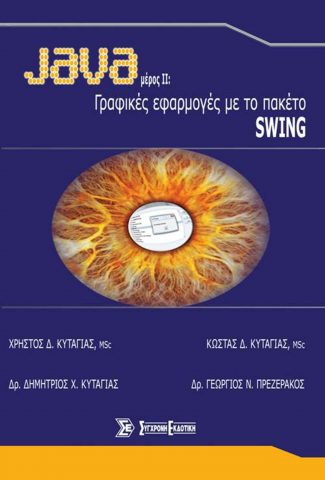
Στόχος του παρόντος βιβλίου είναι να δώσει μια καλή θεμελίωση των εννοιών του αντικειμενοστρεφούς προγραμματισμού και ιδιαίτερα της γλώσσας Java. Στα κυρίως κεφάλαιά του επεξηγούνται όλα τα συστατικά στοιχεία (components) της βιβλιοθήκης Swing με την οποία μπορούν να αναπτυχθούν εφαρμογές που να διαθέτουν γραφική διεπαφή με τον τελικό χρήστη (Graphical User Interface – GUI).

The book consists of two Parts. Part-1 focuses on Business Administration, and Part-2 on Finance and Accounting. John Osborn’s adventures permeate through both parts under the title: «Storyline». An Epilogue concludes the story. Additionally, there is a grammar supplement, by the title: Language Notes Revisited, which highlights the grammar themes various texts and exercises refer to. The book also includes a Glossary of Terms, which doesnot provide English definitions, since they are included in the texts, as well as a Key to the exercises.

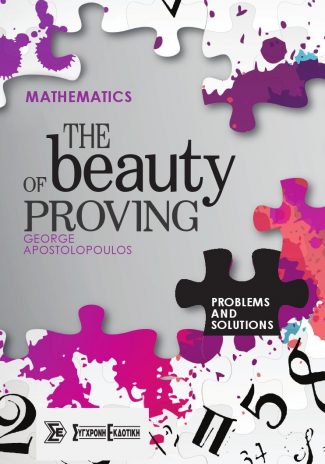
Το βιβλίο απευθύνεται σε ταλαντούχους μαθητές Λυκείου οι οποίοι προτίθενται να συμμετάσχουν στους διαγωνισμούς που διοργανώνει η Ελληνική Μαθηματική Εταιρεία, καθηγητές γυμνασίου που αναζητούν σημαντικά προβλήματα για τις τάξεις και σε όσους καταπιάνονται με μαθηματικά προβλήματα και λύσεις.
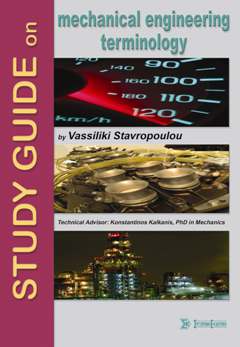
Study Guide on Mechanical Engineering Terminology is a course intended for upper-intermediate and advanced level learners of English (B2-C2) studying mechanical engineering, or for people already working in the field (i.e. the aircraft industry, the automotive industry, the marine industry). It is suitable for use in university and technical school settings, or in-company training programs. It can also be used for self-study.
Study Guide on Mechanical Engineering Terminology is content-based and covers a wide range of mechanical engineering topics, using adapted texts from various sources such as websites, magazines, dictionaries, encyclopedias. It contains tasks to review and practice the vocabulary and language functions in the Student’s book (English for Mechanical Engineering) through new reading texts and further reading, speaking and writing tasks. It can be used in combination with the Student’s book as a complementary practice and revision tool, or independently as a crash course in technical terminology. It contains twelve units. Each one is designed to provide approximately two to three hours’ work.
Key features of the Study Guide
. Twelve content-based units.
. Pre-text tasks to activate students’ background knowledge.
. Reading skills development.
. Vocabulary development through, for instance, puzzles which revise vocabulary items.
. A variety of writing tasks.
. Frequent opportunities for discussion.
. Free reading tasks that stimulate the learners’ interest and serve not only to enhance their reading and speaking skills, but also to develop their general outlook.
. Focus on using functional language.
. Full answer key to all exercises and tasks.
. Two concise glossaries of mechanical engineering.
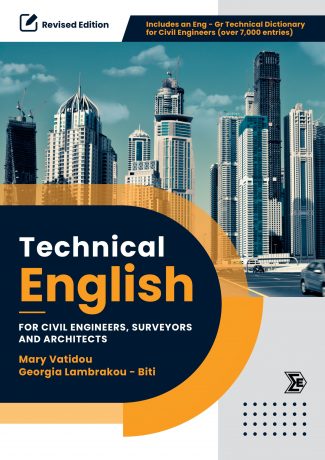
This book has been designed to meet the needs of University students, who have an intermediate knowledge of English. It may also be used as a reference book for professionals. It has been the result of long teaching efforts at the Dept. of Civil Engineering at the University of West Attica. It will enable the readers to learn up – to – date technical terms, understand authentic texts, improve their communicative skills and write technical reports.
Technical English for Civil Engineers, Surveyors and Architects contains 18 units based on authentic text material provided with illustrations and diagrams. Emphasis is placed on reading and understanding which is checked through a variety of exercises and activities. Each unit begins with a reading passage that deals with building construction, architectural theory or surveying followed by comprehension questions on the passage, True/False statements and multiple choice exercises. The Language work which follows contains notes on particular points of grammar with exercises on those points. At the end of each unit there is terminology including words and terms referred to each unit.
The end of the book contains English-Greek Civil Engineering Technical Dictionary which provides students with adequate knowledge of the technical terms they will meet during their studies and profession.
This revised edition of the book intends to update the current needs of civil engineers, architects and surveyors.
We would finally like to acknowledge Paris Bitis Computer Engineer and John Bitis Civil Engineer for their valuable contribution and assistance.
A teacher’s key is also available.
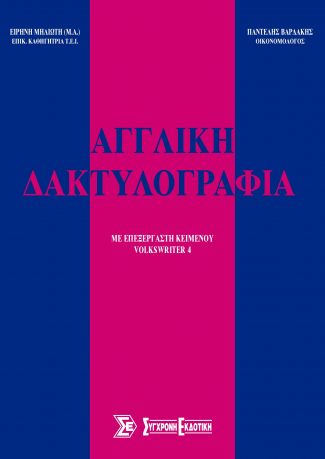
Tο παρόν αποτελείται από τρία μέρη. Στο πρώτο παρουσιάζονται ασκήσεις εκμάθησης του Aγγλικού πληκτρολογίου, έτσι ώστε ο ασκούμενος να εξοικειωθεί με τις θέσεις των δακτύλων στο πληκτρολόγιο. Στο δεύτερο μέρος γίνεται μια συνοπτική παρουσίαση ενός εύχρηστου επεξεργαστή κειμένου και στο τελευταίο μέρος παρουσιάζονται τύποι εμπορικών επιστολών και κείμενα για εξάσκηση.
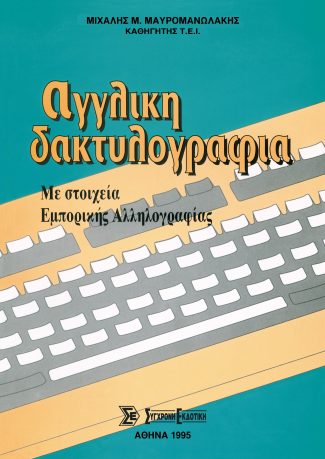
Σκοπός του βιβλίου είναι η ανάπτυξη της τεχνικής ικανότητας στο πληκτρολόγιο, που είναι αναγκαία για την αποτελεσματική χρήση της αγγλικής γραφομηχανής με «τυφλό» σύστημα. O τελικός στόχος είναι ο αναγνώστης να αναπτύξει και να βελτιώσει την ικανότητα δακτυλογράφησης-πληκτρολόγησης ξενόγλωσσων κειμένων με ταχύτητα και ακρίβεια για να μπορεί να γράφει διάφορα έγγραφα.

Tο παρόν βιβλίο διερευνά τα περί τόκου από την εποχή των Kλασσικών μέχρι σήμερα. Στόχος αυτού του πονήματος είναι να βοηθήσει τον αναγνώστη να εμβαθύνει αναλυτικότερα στη διαμόρφωση και προσδιορισμό του οικονομικού φαινομένου του τόκου.
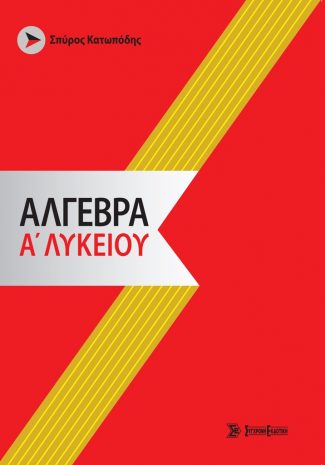
Το παρόν βιβλίο σε καμία των περιπτώσεων δεν έρχεται να αντικαταστήσει το σχολικό βιβλίο του Υπουργείου Παιδείας.
Αποτελεί ένα επιπλέον εργαλείο στα χέρια των μαθητών οι οποίοι μέσω αυτού θα έχουν την δυνατότητα να προσεγγίσουν τα Μαθηματικά υπό ένα πρίσμα περισσότερο συνοπτικό, σύντομο, απλό και κατανοητό.
Θα έχουν δε την ευκαιρία να εξασκηθούν σε ακόμα περισσότερες, του σχολικού βιβλίου, ασκήσεις και να διευρύνουν, κατά αυτόν τον τρόπο, τον ορίζοντα των μαθηματικών τους γνώσεων.
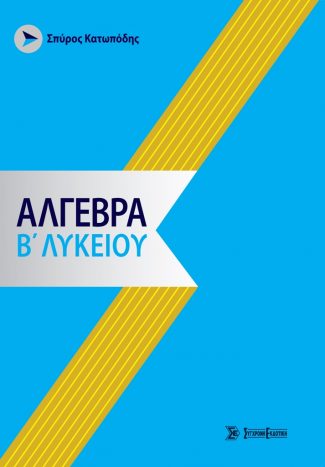
Το παρόν βιβλίο σε καμία των περιπτώσεων δεν έρχεται να αντικαταστήσει το σχολικό βιβλίο του Υπουργείου Παιδείας.
Αποτελεί ένα επιπλέον εργαλείο στα χέρια των μαθητών οι οποίοι μέσω αυτού θα έχουν την δυνατότητα να προσεγγίσουν τα Μαθηματικά υπό ένα πρίσμα περισσότερο συνοπτικό, σύντομο, απλό και κατανοητό.
Θα έχουν δε την ευκαιρία να εξασκηθούν σε ακόμα περισσότερες, του σχολικού βιβλίου, ασκήσεις και να διευρύνουν, κατά αυτόν τον τρόπο, τον ορίζοντα των μαθηματικών τους γνώσεων.